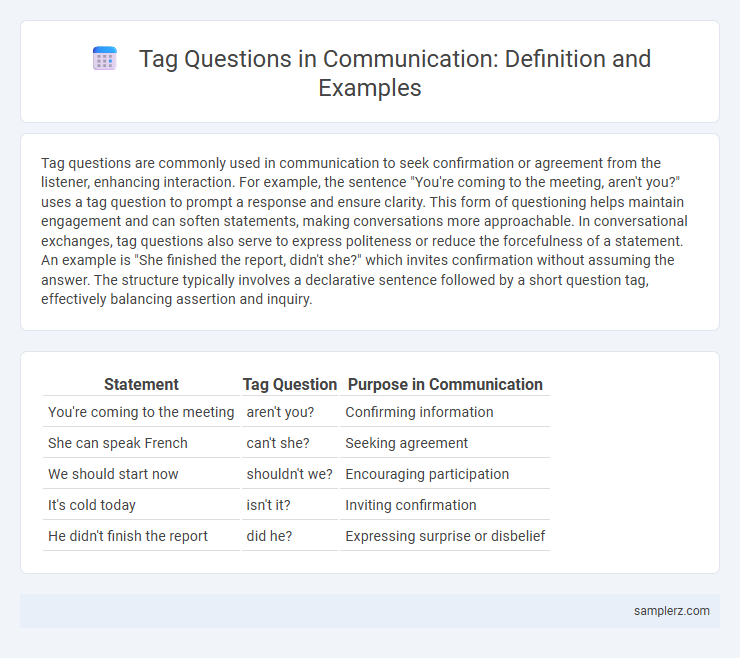Tag questions are commonly used in communication to seek confirmation or agreement from the listener, enhancing interaction. For example, the sentence "You're coming to the meeting, aren't you?" uses a tag question to prompt a response and ensure clarity. This form of questioning helps maintain engagement and can soften statements, making conversations more approachable. In conversational exchanges, tag questions also serve to express politeness or reduce the forcefulness of a statement. An example is "She finished the report, didn't she?" which invites confirmation without assuming the answer. The structure typically involves a declarative sentence followed by a short question tag, effectively balancing assertion and inquiry.
Table of Comparison
| Statement | Tag Question | Purpose in Communication |
|---|---|---|
| You're coming to the meeting | aren't you? | Confirming information |
| She can speak French | can't she? | Seeking agreement |
| We should start now | shouldn't we? | Encouraging participation |
| It's cold today | isn't it? | Inviting confirmation |
| He didn't finish the report | did he? | Expressing surprise or disbelief |
Understanding Tag Questions in Communication
Tag questions in communication serve to confirm information or seek agreement, such as in "You're joining the meeting, aren't you?" This form enhances interaction by encouraging participation and clarifying understanding between speakers. Effective use of tag questions improves conversational flow and reduces misunderstandings in both personal and professional communication contexts.
Common Examples of Tag Questions
Tag questions commonly appear in communication to confirm information or seek agreement, such as "It's cold today, isn't it?" and "You've finished the report, haven't you?" These examples help engage listeners and encourage responses, enhancing interaction and clarity in conversations. Using tag questions effectively supports smoother dialogue and reinforces understanding between speakers.
Tag Questions for Seeking Confirmation
Tag questions such as "You're coming to the meeting, aren't you?" serve as effective tools for seeking confirmation in communication by prompting a response that verifies information. These questions balance assertiveness with politeness, encouraging engagement and clarity between speakers. Utilizing tag questions enhances interpersonal interactions by reducing misunderstandings and ensuring mutual agreement on discussed points.
Tag Questions in Everyday Conversations
Tag questions enhance clarity and engagement in everyday conversations by inviting confirmation or feedback, such as in the sentence "You're coming to the meeting, aren't you?" These expressions help speakers check understanding and encourage interaction, making communication more dynamic and responsive. Common tag questions include forms like "isn't it?", "don't they?", and "can't we?", which are integral to effective verbal exchanges.
Tag Questions to Express Uncertainty
Tag questions such as "You're coming to the meeting, aren't you?" serve as effective tools to express uncertainty and seek confirmation in communication. These brief inquiries encourage the listener to verify information, softening statements that might otherwise appear assertive or presumptive. Utilizing tag questions enhances conversational engagement by prompting responses and clarifying doubts without direct confrontation.
Positive and Negative Tag Question Examples
A positive tag question pairs a positive statement with a negative question tag, such as "You're coming to the meeting, aren't you?" to confirm information politely. A negative tag question uses a negative statement with a positive question tag, for example, "You don't have the report ready, do you?" which often seeks reassurance or clarification. These tag questions enhance engagement and encourage responses in conversations, making communication more interactive.
Using Tag Questions in Formal Communication
Using tag questions in formal communication enhances clarity and encourages engagement without sounding confrontational, such as in the phrase, "The report is accurate, isn't it?" This technique helps confirm information politely, ensuring mutual understanding between professionals. Carefully constructed tag questions maintain a respectful tone while inviting feedback or agreement in business meetings and official correspondence.
Tag Questions to Encourage Engagement
Tag questions such as "You're coming to the meeting, aren't you?" serve as effective tools in communication to invite confirmation and increase listener participation. Using tag questions encourages engagement by prompting responses, making conversations more interactive and inclusive. This technique helps speakers gauge understanding and foster a collaborative atmosphere in both personal and professional settings.
Cultural Differences in Tag Question Usage
Tag question usage varies significantly across cultures, reflecting different communication styles and social norms. For example, in British English, tag questions like "It's cold today, isn't it?" often seek confirmation or soften statements, whereas in some Asian cultures, tag questions may be used less frequently or carry different pragmatic functions. Understanding these cultural differences enhances cross-cultural communication and reduces misunderstandings in international interactions.
Tips for Using Tag Questions Effectively
Using tag questions like "You're joining the meeting, aren't you?" encourages engagement and confirms understanding in communication. Keep the tone friendly and match the tag's polarity to avoid confusion and promote clarity. Incorporate tag questions strategically to invite responses and maintain conversational flow without sounding intrusive.

example of tag question in communication Infographic
 samplerz.com
samplerz.com